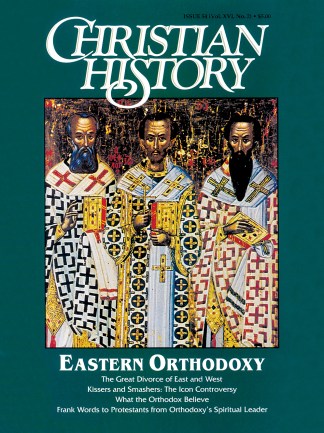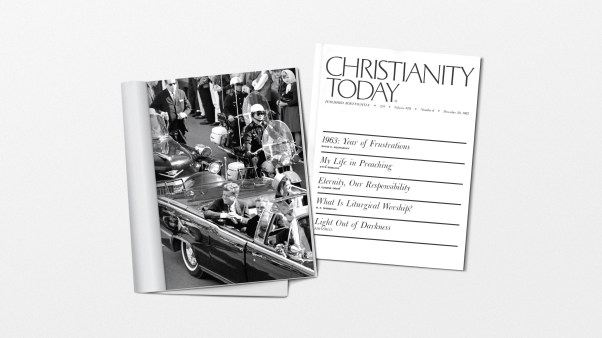In this series

The Orthodox Church is not a single church but rather a family of 13 “autocephalous,” or self-governing, churches. They are united in their understanding of the sacraments, doctrine, liturgy, and church government, but each administers its own affairs.
The head of each autocephalous church is called a “patriarch” or “metropolitan.” The patriarch of Constantinople (that is, Istanbul, Turkey) is considered the “ecumenical,” or universal, patriarch. He enjoys special honor but no power to interfere with the 12 other Orthodox communions.
Many Westerners have been confused about Orthodoxy’s distinct identity. In the American armed services, military identification tags of enlisted Orthodox believers once bore the inscription “Protestant.”
On the other hand, some western theologians have dismissed Orthodoxy outright. Nineteenth-century church historian Adolf von Harnack wrote, “The Orthodox Church is in her entire structure alien to the gospel and represents a perversion of the Christian religion, its reduction to the level of pagan antiquity.”
The Orthodox Church claims to be the one, true church of Christ. Orthodox thinkers debate the spiritual status of Roman Catholics and Protestants, and a few still consider them heretics.
The doctrine of justification by faith is virtually absent from the history and theology of Orthodoxy. Rather, Orthodoxy emphasizes theosis (literally, “divinization”), the gradual process by which Christians become more and more like Christ.
The Orthodox have experienced more brutal and lasting persecution than any other Christian body. Under Soviet atheism, for example, communists closed 98 percent of the Orthodox churches in Russia, as well as 1,000 monasteries and 60 seminaries. Between 1917 and the outbreak of World War II, some 50,000 Orthodox priests were martyred.
Orthodox Christians number about 215 million worldwide, with about 5.6 million in the United States. This makes American Orthodoxy about the size of the Presbyterian Church (PCUSA) and the Episcopal Church together.
In the last decade, many Protestants have converted to Orthodoxy. In 1987 former Campus Crusade for Christ staffer Peter Gillquist led 2,000 evangelicals in joining the Antiochian Orthodox Church. Another well-known convert is Franky Schaeffer, son of the late apologist Francis Schaeffer.
Orthodox worship can last two or more hours. Since Orthodox churches do not usually have pews, worshipers variously stand, kneel, and lie prostrate, depending on what the liturgy calls for.
Many Orthodox churches still follow the Julian calendar, authorized by Julius Caesar and used in Europe and the Mediterranean through the Middle Ages. Western churches adhere to the Gregorian calendar, Pope Gregory XIII’s 1582 revision of the Julian. Because the Julian calendar now runs 13 days behind the Gregorian, many Orthodox celebrate holy days almost two weeks after the West.
The five largest Orthodox churches in the world are:
- Russian (70 to 100 million)
- Romanian (15 million)
- Greek (13 million)
- Serbian (8 million)
- Bulgarian (8 million)
 Canadian evangelicals have not yet got the message of Pierre Berton’s book, The Comfortable Pew, even though most would consider the book and its challenge old hat by now. Berton, himself a communicator, faulted the Church for failure to take seriously the mass media, especially radio and TV. This criticism was repeated in the sequel, The Restless Church, in an essay by the well-known television personality Patrick Watson. Marshall McLuhan, Malcolm Boyd, and a host of others have repeatedly sounded a similar theme. Yet little or nothing is happening as a result.At the time of the Reformation, a man with a Bible in his hands was a supremely modern man—a man with the product of the latest technology (the printing press) at his service. Today evangelicals in Canada act, for the most part, as if radio and TV had not yet been invented. Unlike the Apostle Paul, who was fully committed to flexibility in his evangelistic endeavors—“I have become all things to all men, that I might by all means save some” (1 Cor. 9:22)—we still persist largely in a blind devotion to yesterday’s methods. This is a real hang-up, to use the current phrase.Since we are stewards of the Gospel, two factors underscore the urgency of this issue:1. One cynic has said, There is no god but the electronic tube and McLuhan is its prophet.” The reader may feel that if McLuhan is a prophet, he is a false one; but one idea he has hammered home cannot be ignored. When he says that the medium is the message, we need to listen. The way in which a message is presented is important, sometimes even more important than the message itself. If we continue to rely on antique methods for presenting the Gospel, we are saying loudly and clearly to the world that we have not yet joined the twentieth century. Once this sinks in, the corollary that our message must therefore be irrelevant is adopted almost unwittingly. Yet when Canadian evangelicals talk about mass evangelism, they inevitably have in mind some form of preaching—a monologue or lecture method.2. The point, nevertheless, is not simply that the mass media are the contemporary way to communicate the Gospel; it is that, in many siuations, they are increasingly becoming the only way. As Harvey Cox has pointed out, the “secular city” today crosses all geographical and cultural boundaries. In the “global village,” men live more and more in remarkably similar urban communities characterized by the ubiquitous high-rise apartment buildings.These “filing cases for people” that are swiftly dominating the skyline of today’s city are its most symbolic structure. How do we reach apartment dwellers for Christ? The old technique of lay visitation can no longer be relied on, for often even the minister himself cannot gain admission. He is told over the intercom that Mr. and Mrs. Jones are “busy”—and that’s that.We know, however, that in the evening, after Mr. and Mrs. Jones have come home from the office and had dinner, they draw the curtains, pour themselves a drink, and turn on the radio or television set. Hidden away in an anonymous retreat, they put out their antennas and tune in to the communicating world outside. What do they hear from us? Hardly anything.This is not to say that there is no religious radio and TV programming in Canada; obviously there is. But candor demands the admission that most of what is being done falls very wide of the mark.Evangelical churches often take the matter seriously enough to get involved; and yet they persist, in the main, in a “hard sell” gospel-music-plus-sermon approach that turns off all but the already converted. Thousands of dollars are spent in an effort that purports to be outreach but actually turns out to be a conversation among Christians. These programs have a pastoral value, no doubt; but they are not reaching the world to which we have been sent.The churches bring to the modern media their own prepackaged programs, taken more or less straight out of a church-service setting, and insist that they be sent out as they are. Not only is that strategy bad; it is based on a failure to appreciate the real theological basis for Christian communications.At the risk of over-simplification, this theological basis can be summed up under two points: (1) Our God is a communicating God who has revealed himself in Jesus Christ and has called us who worship him to be communicators also. (2) As One who communicates himself, God takes this world as it is seriously—so seriously, in fact, that the Word became flesh for all. It is this incarnational aspect—this taking the world seriously—that has been neglected. We cannot pretend to take the media seriously so long as we dictate the terms on which we will condescend to use them. They have their own “flesh” that can become the medium for the Gospel only as we face the cost of emptying or humbling ourselves for the task.Our shortsightedness becomes very apparent if we ask: How many churches consult their laymen who are involved in broadcasting before they decide on the content and style of religious broadcasts? A Christian radio-station manager said to me the other day, “In all my years of radio I have never once been asked for my opinion on how to communicate the Gospel by an official of my church.”This failure is reflected in the larger stations’ gradual elimination of all religious programs. One large Toronto station can show a significant listening increase (and consequent financial profit) since it discontinued its religious broadcasting.On the other hand, those in the big denominations who do take advantage of the media so often end up with a watered-down version of the faith that once again any evangelistic thrust is nullified. Indeed, some of the ablest communicators seem to go out of their way to disparage the beliefs they are supposed to represent.All of this might lead us to despair, were it not that we serve the Lord of all hope and have been promised his Holy Spirit, the Chief Communicator, as our guide.Evangelicals must wrestle with this problem until some answers appear. It is not necessary to accept an either-or; we can use the media effectively and yet present the eternal Gospel. If current experience shows that the “Hot Line” format and the paid religious commercial are the forms most acceptable to radio and TV at present, then we must concentrate more effort there. And conferences for laymen with communication skills are a must if we mean to tackle the job seriously. It is still not too late to hear and obey the challenge:Give the winds a mighty voice—Jesus saves!—T. W. HARPUR, professor of New Testament, Wycliffe College, Toronto, Canada.
Canadian evangelicals have not yet got the message of Pierre Berton’s book, The Comfortable Pew, even though most would consider the book and its challenge old hat by now. Berton, himself a communicator, faulted the Church for failure to take seriously the mass media, especially radio and TV. This criticism was repeated in the sequel, The Restless Church, in an essay by the well-known television personality Patrick Watson. Marshall McLuhan, Malcolm Boyd, and a host of others have repeatedly sounded a similar theme. Yet little or nothing is happening as a result.At the time of the Reformation, a man with a Bible in his hands was a supremely modern man—a man with the product of the latest technology (the printing press) at his service. Today evangelicals in Canada act, for the most part, as if radio and TV had not yet been invented. Unlike the Apostle Paul, who was fully committed to flexibility in his evangelistic endeavors—“I have become all things to all men, that I might by all means save some” (1 Cor. 9:22)—we still persist largely in a blind devotion to yesterday’s methods. This is a real hang-up, to use the current phrase.Since we are stewards of the Gospel, two factors underscore the urgency of this issue:1. One cynic has said, There is no god but the electronic tube and McLuhan is its prophet.” The reader may feel that if McLuhan is a prophet, he is a false one; but one idea he has hammered home cannot be ignored. When he says that the medium is the message, we need to listen. The way in which a message is presented is important, sometimes even more important than the message itself. If we continue to rely on antique methods for presenting the Gospel, we are saying loudly and clearly to the world that we have not yet joined the twentieth century. Once this sinks in, the corollary that our message must therefore be irrelevant is adopted almost unwittingly. Yet when Canadian evangelicals talk about mass evangelism, they inevitably have in mind some form of preaching—a monologue or lecture method.2. The point, nevertheless, is not simply that the mass media are the contemporary way to communicate the Gospel; it is that, in many siuations, they are increasingly becoming the only way. As Harvey Cox has pointed out, the “secular city” today crosses all geographical and cultural boundaries. In the “global village,” men live more and more in remarkably similar urban communities characterized by the ubiquitous high-rise apartment buildings.These “filing cases for people” that are swiftly dominating the skyline of today’s city are its most symbolic structure. How do we reach apartment dwellers for Christ? The old technique of lay visitation can no longer be relied on, for often even the minister himself cannot gain admission. He is told over the intercom that Mr. and Mrs. Jones are “busy”—and that’s that.We know, however, that in the evening, after Mr. and Mrs. Jones have come home from the office and had dinner, they draw the curtains, pour themselves a drink, and turn on the radio or television set. Hidden away in an anonymous retreat, they put out their antennas and tune in to the communicating world outside. What do they hear from us? Hardly anything.This is not to say that there is no religious radio and TV programming in Canada; obviously there is. But candor demands the admission that most of what is being done falls very wide of the mark.Evangelical churches often take the matter seriously enough to get involved; and yet they persist, in the main, in a “hard sell” gospel-music-plus-sermon approach that turns off all but the already converted. Thousands of dollars are spent in an effort that purports to be outreach but actually turns out to be a conversation among Christians. These programs have a pastoral value, no doubt; but they are not reaching the world to which we have been sent.The churches bring to the modern media their own prepackaged programs, taken more or less straight out of a church-service setting, and insist that they be sent out as they are. Not only is that strategy bad; it is based on a failure to appreciate the real theological basis for Christian communications.At the risk of over-simplification, this theological basis can be summed up under two points: (1) Our God is a communicating God who has revealed himself in Jesus Christ and has called us who worship him to be communicators also. (2) As One who communicates himself, God takes this world as it is seriously—so seriously, in fact, that the Word became flesh for all. It is this incarnational aspect—this taking the world seriously—that has been neglected. We cannot pretend to take the media seriously so long as we dictate the terms on which we will condescend to use them. They have their own “flesh” that can become the medium for the Gospel only as we face the cost of emptying or humbling ourselves for the task.Our shortsightedness becomes very apparent if we ask: How many churches consult their laymen who are involved in broadcasting before they decide on the content and style of religious broadcasts? A Christian radio-station manager said to me the other day, “In all my years of radio I have never once been asked for my opinion on how to communicate the Gospel by an official of my church.”This failure is reflected in the larger stations’ gradual elimination of all religious programs. One large Toronto station can show a significant listening increase (and consequent financial profit) since it discontinued its religious broadcasting.On the other hand, those in the big denominations who do take advantage of the media so often end up with a watered-down version of the faith that once again any evangelistic thrust is nullified. Indeed, some of the ablest communicators seem to go out of their way to disparage the beliefs they are supposed to represent.All of this might lead us to despair, were it not that we serve the Lord of all hope and have been promised his Holy Spirit, the Chief Communicator, as our guide.Evangelicals must wrestle with this problem until some answers appear. It is not necessary to accept an either-or; we can use the media effectively and yet present the eternal Gospel. If current experience shows that the “Hot Line” format and the paid religious commercial are the forms most acceptable to radio and TV at present, then we must concentrate more effort there. And conferences for laymen with communication skills are a must if we mean to tackle the job seriously. It is still not too late to hear and obey the challenge:Give the winds a mighty voice—Jesus saves!—T. W. HARPUR, professor of New Testament, Wycliffe College, Toronto, Canada.Daniel Clendenin is author of Eastern Orthodox Christianity: A Western Perspective (Baker, 1994). He serves with InterVarsity Christian Fellowship at Stanford University.
Copyright © 1997 by the author or Christianity Today/Christian History magazine. Click here for reprint information on Christian History.












